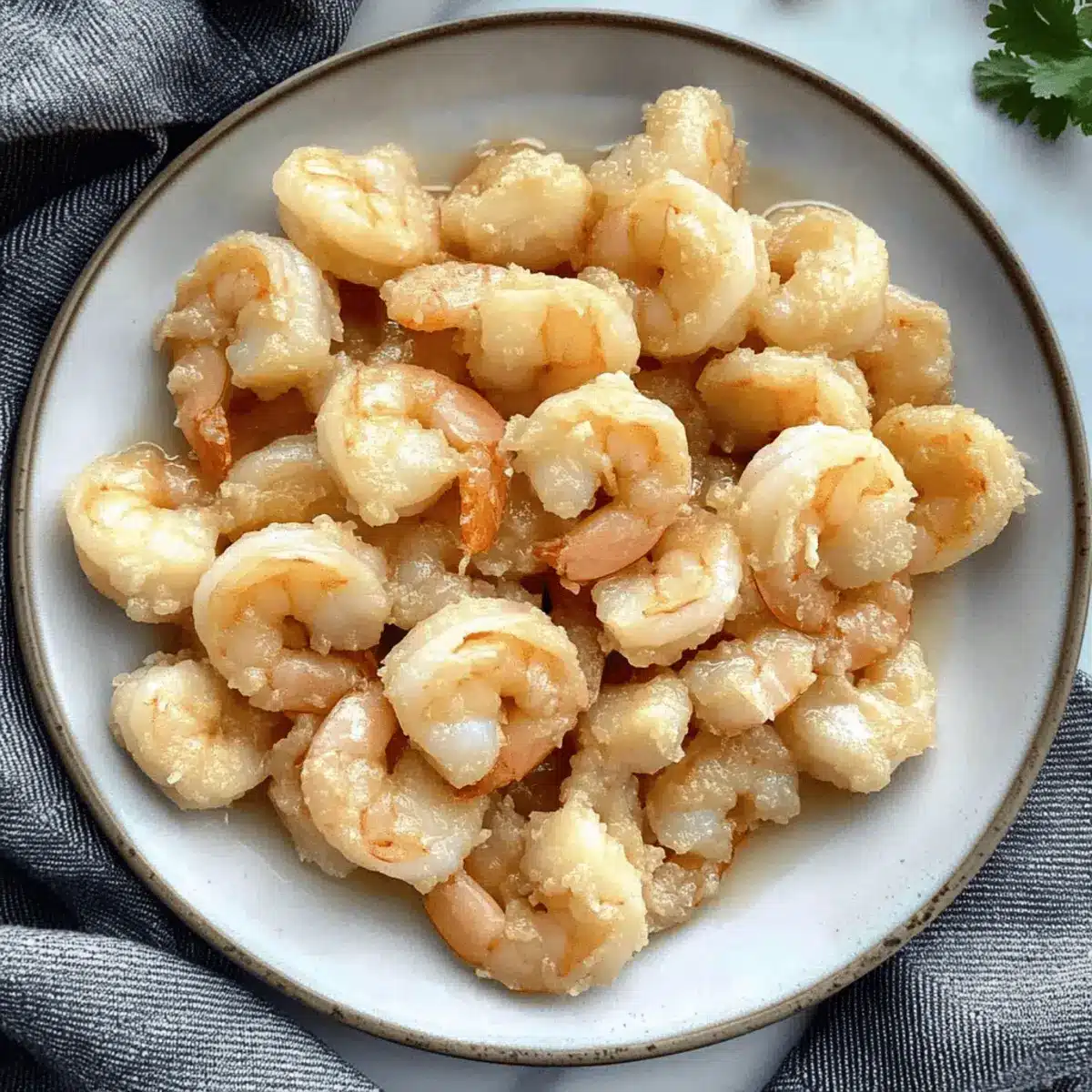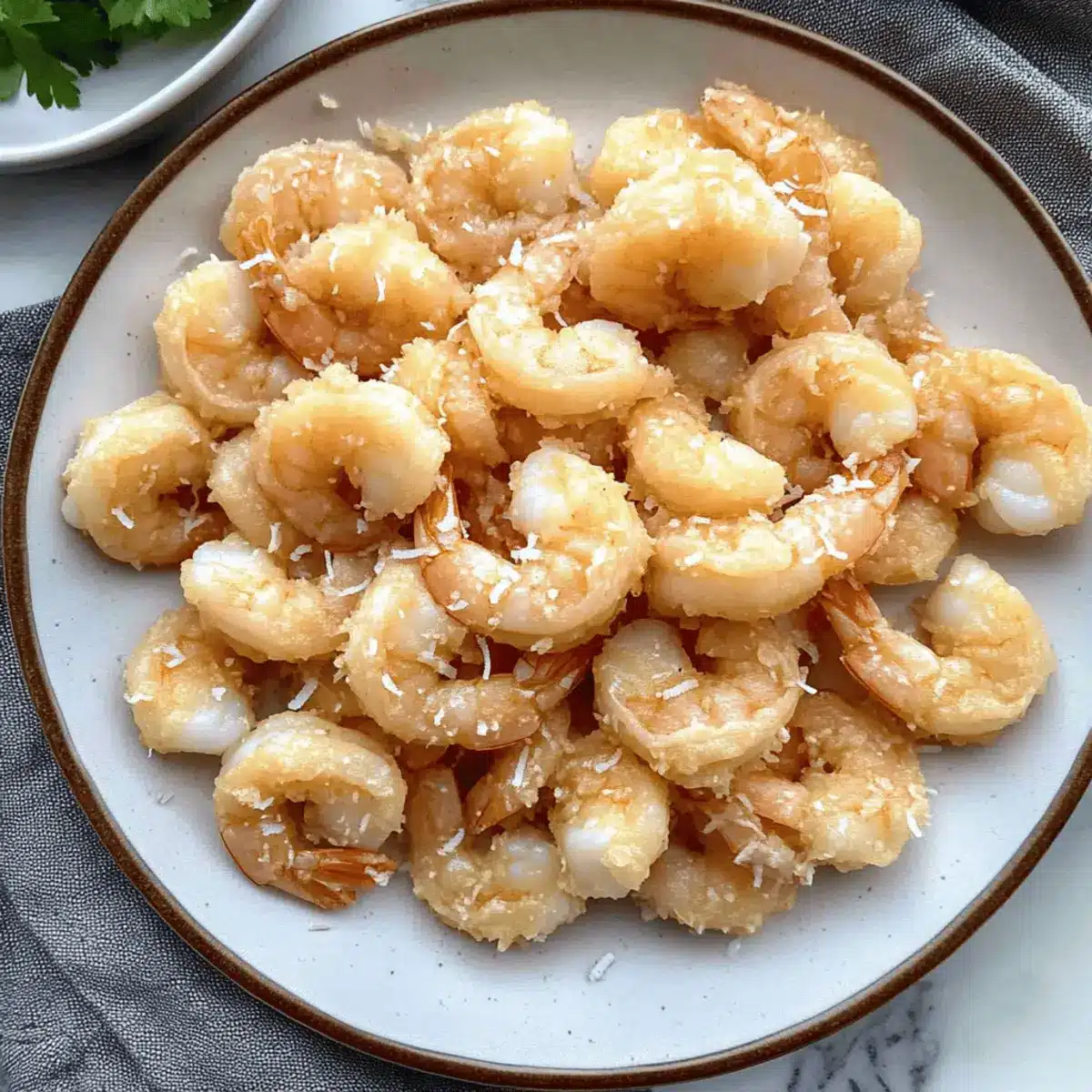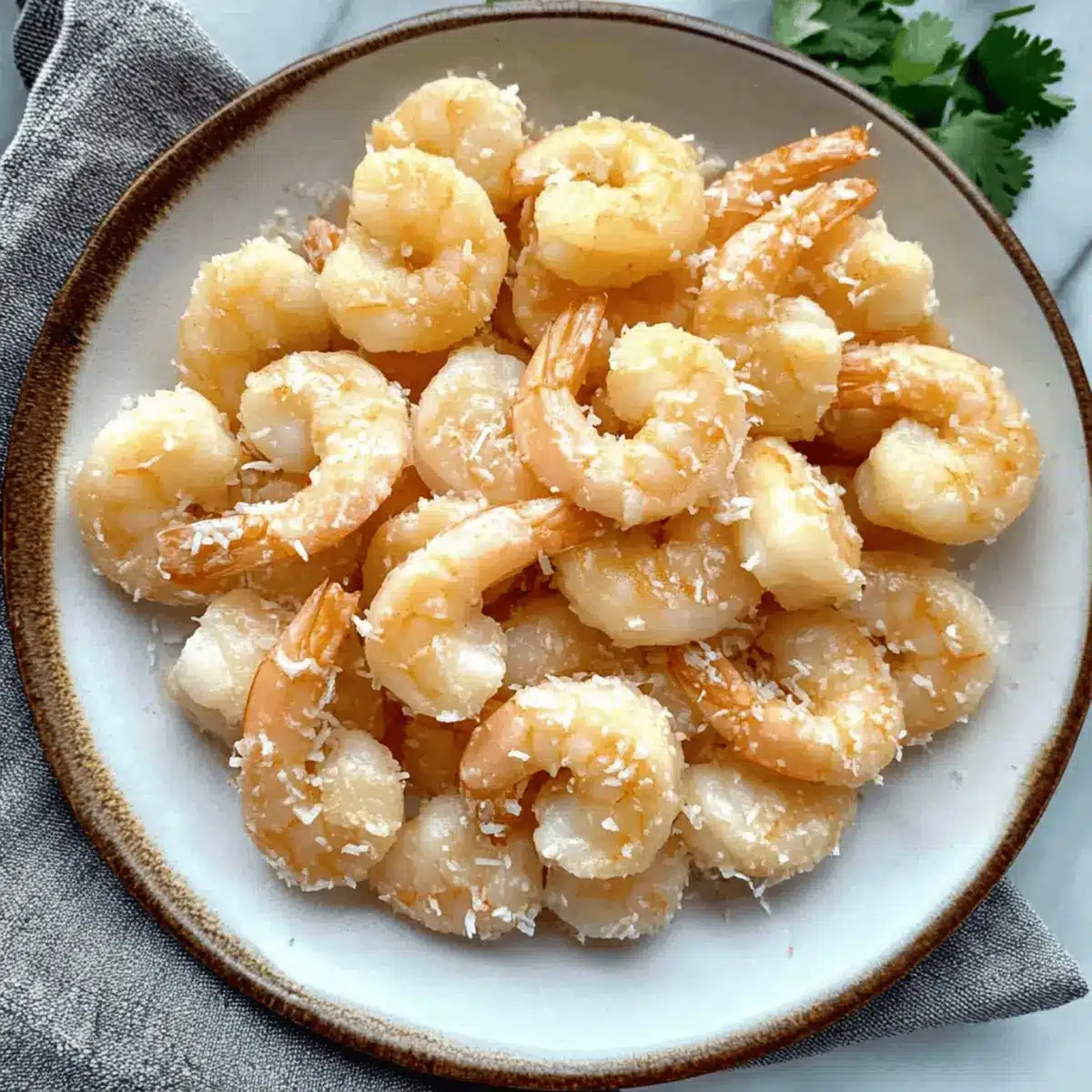In the midst of a bustling weekend, I found myself longing for the vibrant flavors of my favorite Chinese buffet. It was then that the idea of making Crispy Chinese Coconut Shrimp at home sparked my imagination. The moment you bite into these golden morsels, the delightful crunch paired with a creamy coconut sauce takes you on a culinary journey that’s both comforting and satisfying. What I love most about this dish is its quick preparation—ideal for a weekend feast—and how it effortlessly impresses guests, making it a true crowd-pleaser. Whether you’re serving it alongside steamed rice or a vibrant salad, this recipe turns everyday dining into a celebration. Are you ready to dive into some irresistible homemade shrimp? Let’s get cooking!

Why is this recipe a must-try?
Simplicity at Its Best: With just a few straightforward steps, you’ll have a homemade Crispy Chinese Coconut Shrimp ready to delight your family.
Decadent Flavor: Every bite combines the sweetness of coconut with a hint of ginger, creating a flavor explosion that rivals any takeout meal.
Versatile Dish: Enjoy it as an appetizer or main course; it pairs beautifully with steamed rice or fresh salad.
Crowd-Pleasing Delight: Perfect for gatherings, this dish is sure to impress your guests with its vibrant presentation and mouth-watering taste.
Healthier Alternative: Say goodbye to greasy takeout—making these at home allows you to control ingredients, ensuring a wholesome feast.
If you love seafood dishes, you might also enjoy our Coconut Shrimp Sweet and Shrimp Scampi Bowls for more cooking inspiration!
Chinese Coconut Shrimp Ingredients
For the Shrimp
• Shrimp – Fresh or frozen, peeled and deveined for the best texture.
• Egg White – Acts as a binding agent; one large egg white works wonders.
• Water or Chinese Rice Wine – Moistens and enhances flavor; rice wine adds a lovely touch.
• Coarse Kosher Salt – Enhances the shrimp’s flavor; table salt can substitute but adjust the quantity.
For the Coconut Sauce
• Coconut Milk – The rich base for your sauce; full-fat is preferred, but light works too if you’re watching calories.
• Sugar – Adds sweetness to balance the flavors; consider other sweeteners if desired.
• Mayonnaise – Provides creaminess; swap it with Greek yogurt for a healthier twist.
• White Vinegar – Balances the sauce’s acidity; any mild vinegar can be a substitute.
For the Breading
• Cornstarch – Key for thickening and achieving that crispy texture; don’t confuse with flour!
• Ginger – Fresh ginger adds an aromatic boost; dried ground ginger is a substitute (use less).
• Neutral Oil – Perfect for frying; can use olive oil cautiously, keeping its flavor in mind.
Dive into these vibrant flavors, and enjoy making your homemade Chinese Coconut Shrimp!
Step‑by‑Step Instructions for Chinese Coconut Shrimp
Step 1: Marinate Shrimp
Begin by combining the peeled and deveined shrimp with one egg white, a splash of water or Chinese rice wine, and a generous pinch of coarse kosher salt in a mixing bowl. Allow the shrimp to marinate for at least 10 minutes or up to 4 hours in the refrigerator. This step enhances flavor and helps the coating stick, setting the stage for your delicious Chinese Coconut Shrimp.
Step 2: Prepare Coconut Sauce
In a separate bowl, whisk together full-fat coconut milk, sugar, mayonnaise, white vinegar, cornstarch, and a sprinkle of salt until well combined. Heat a tablespoon of neutral oil in a saucepan over medium heat, then sauté freshly grated ginger for about 45 seconds. Pour the coconut mixture into the pan and cook until it begins to bubble, stirring constantly until thickened. Set this silky sauce aside, allowing it to cool slightly.
Step 3: Bread the Shrimp
In a large mixing bowl, combine cornstarch and baking powder thoroughly. Take about a quarter cup of this mixture and blend it into the shrimp marinade, ensuring an even coating. One by one, dredge each shrimp in the cornstarch mixture and place them on a clean baking sheet. At this point, your shrimp should look lightly coated and ready to fry, promising an enticing crunch in the final result.
Step 4: Fry Shrimp
Heat enough neutral oil in a deep skillet or heavy-bottomed pot to reach 350°F (175°C). Once the oil is shimmering, carefully add the breaded shrimp in small batches, ensuring they have space to fry without crowding. Fry each batch for about 1-2 minutes, or until they turn golden brown and crispy. Use a slotted spoon to remove the shrimp and drain them on a wire rack to keep them crisp as you continue cooking the rest.
Step 5: Combine and Serve
Reheat the prepared coconut sauce over low heat, stirring gently to incorporate any separated ingredients. Once warm, add the freshly fried shrimp into the sauce and toss until each piece is beautifully coated. Serve your homemade Chinese Coconut Shrimp immediately for the best texture and flavor. Pair it with steamed rice or a fresh salad to create an impressive meal that’s sure to delight family and friends.

How to Store and Freeze Chinese Coconut Shrimp
Refrigerator: Store leftovers in an airtight container for up to 3 days. To keep the shrimp crispy, store separately from the coconut sauce.
Freezer: Place cooled, breaded shrimp in a single layer on a baking sheet. Freeze for about 1-2 hours, then transfer to a freezer-safe bag or container, where they can be kept for up to 2 months.
Reheating: Reheat frozen shrimp directly from the freezer in a preheated oven at 400°F (200°C) for about 12-15 minutes until heated through and crispy.
Coconut Sauce: Store the sauce separately in the refrigerator for up to 5 days. Reheat gently on the stove or microwave before serving with your Chinese Coconut Shrimp.
Make Ahead Options
Preparing your Chinese Coconut Shrimp in advance is a fantastic way to save time on busy weeknights! You can marinate the shrimp (combine shrimp, egg white, water, and salt) and refrigerate them for up to 24 hours. The coconut sauce can also be made a day ahead; simply refrigerate it and reheat when you’re ready to toss in your shrimp. To maintain the crispy texture, bread the shrimp just before frying. When it’s time to serve, fry the breaded shrimp in hot oil for about 1-2 minutes until golden brown, then mix with the warm sauce for an unforgettable dish that’s just as delicious as when prepared fresh!
Variations for Chinese Coconut Shrimp
Feel free to get creative and customize your coconut shrimp to match your taste buds!
-
Panko Breadcrumbs: Switch out regular breadcrumbs for panko to achieve an extra crunchy texture that elevates each bite. The airy crunch adds a delightful contrast to the creamy sauce.
-
Vegetarian Delight: Substitute shrimp with cauliflower florets or tempeh for a delicious vegetarian twist. Both options absorb the flavors beautifully and make for a satisfying alternative.
-
Spicy Kick: Add a pinch of cayenne pepper or hot sauce to the marinade or coconut sauce for an exciting spicy twist. This will awaken the palate and add a fiery punch to your dish.
-
Citrus Zest: Incorporate a little lime or lemon zest into the coconut sauce for a fresh burst of acidity. The citrus brightens the creaminess, making every bite refreshing.
-
Alternative Sauces: Experiment by swapping out coconut milk for a spicy peanut sauce or a sweet chili sauce. Both options turn your shrimp into an entirely new culinary experience!
-
Herb Infusion: Mix in fresh herbs like cilantro or basil into the coconut sauce for added freshness. This delightful touch brings an aromatic element that compliments the dish beautifully.
-
Coconut Variety: Use flavored coconut milk, such as lemongrass or pandan, to impart a unique twist to both the shrimp and the sauce. This variation can transport your taste buds right to Southeast Asia.
If you’re also on the hunt for more seafood inspiration, don’t miss out on our recipes for Coconut Shrimp Sweet and Shrimp Scampi Bowls—they’re sure to delight!
What to Serve with Chinese Coconut Shrimp
Create an unforgettable dining experience by complementing your crispy delights with these mouthwatering sides.
-
Steamed Jasmine Rice: A classic pairing, the fluffy texture provides the perfect canvas for soaking up the creamy coconut sauce.
-
Crisp Green Salad: Toss fresh greens with a light vinaigrette to add a refreshing kick, balancing the richness of the shrimp.
-
Sweet Chili Sauce: Drizzle this tangy sauce over the shrimp for an extra layer of flavor, enhancing both sweetness and heat.
-
Sautéed Snow Peas: Their crunchy texture and subtle sweetness create a delightful contrast, offering a fresh element to your meal.
-
Coconut Rice: Infuse your rice with coconut milk for an aromatic twist that elevates the whole plate, harmonizing beautifully with the shrimp.
-
Mango Salsa: The sweetness of fresh mango combined with a hint of lime will brighten each bite, making for a vibrant side that’s hard to resist.
-
Chilled Cucumber Salad: Cool slices of cucumber mixed with a splash of rice vinegar offer a light and refreshing palate cleanser.
-
Lychee Martini: For a fun drink option, the fruity notes of this cocktail pair perfectly with the tropical essence of the coconut shrimp.
-
Pineapple Upside Down Cake: Satisfy your sweet tooth with this classic dessert that echoes the flavors of a tropical paradise.
Expert Tips for Chinese Coconut Shrimp
-
Preheat Oil: Ensure your oil reaches 350°F (175°C) before frying for that perfect crispy texture. A thermometer will help avoid sogginess.
-
Do Not Overcrowd: Fry shrimp in small batches to maintain oil temperature. Overcrowding leads to steaming instead of frying, resulting in less crispy results.
-
Proper Breading: Coat the shrimp thoroughly with the cornstarch mixture for even crunchiness. Avoid flour, as it doesn’t provide the same crispy finish in your Chinese Coconut Shrimp.
-
Fresh Ingredients: Use fresh ginger for the most aromatic flavor in your coconut sauce. Dried ginger can work, but its potency is much milder.
-
Draining the Shrimp: Let the fried shrimp rest on a wire rack to ensure they stay crispy; paper towels may make them soggy.
-
Sauce Adjustments: Feel free to taste and adjust the coconut sauce’s sweetness to your preference, ensuring it perfectly complements the dish.

Chinese Coconut Shrimp Recipe FAQs
How do I select ripe and fresh shrimp for this recipe?
Absolutely! Look for shrimp that are firm to the touch, with a translucent color and a mild, ocean-like smell. Avoid any that are gritty or have dark spots all over, as this indicates they may not be fresh. If using frozen shrimp, ensure they’re properly thawed and have a clean appearance.
What is the best way to store leftover Chinese Coconut Shrimp?
Very good question! Store any leftover shrimp in an airtight container in the refrigerator for up to 3 days. To maintain their crispy texture, keep the shrimp separate from the coconut sauce. If you have leftover sauce, it can be refrigerated separately for up to 5 days.
Can I freeze the Chinese Coconut Shrimp, and if so, how?
Absolutely! To freeze, first, let the cooked shrimp cool completely. Then, lay them in a single layer on a baking sheet and freeze for about 1-2 hours until firm. Afterward, transfer the shrimp into a freezer-safe bag or container. They can be stored in the freezer for up to 2 months. For reheating, directly bake the frozen shrimp in a preheated oven at 400°F (200°C) for about 12-15 minutes until heated through and crispy.
What if my coconut sauce is too thick or too thin?
Don’t worry, I’ve been there too! If your sauce is too thick, gradually stir in a small amount of water or additional coconut milk until you reach the desired consistency. If it’s too thin, simply continue to cook it over low heat, stirring frequently to allow it to reduce and thicken. Adding a touch of cornstarch mixed with water can also help thicken it up faster.
Are there any dietary considerations for this dish?
Certainly! This recipe contains seafood, so it’s not suitable for those with shellfish allergies. Some ingredients, like mayonnaise, can be swapped for alternatives like Greek yogurt to accommodate dietary preferences. If you’re concerned about gluten or specific dietary needs, check the labels of your corn starch and any sauces used.
How do I ensure the shrimp are crispy when frying?
Very important! Make sure the oil is preheated to 350°F (175°C) before adding the shrimp. If the oil is too cool, it will cause the shrimp to absorb too much oil, resulting in sogginess. Fry in small batches to avoid overcrowding the pan, which helps maintain the oil temperature and ensures every shrimp comes out beautifully crispy!

Deliciously Crunchy Chinese Coconut Shrimp You Can Make at Home
Ingredients
Equipment
Method
- Marinate shrimp by combining peeled and deveined shrimp with egg white, water or Chinese rice wine, and kosher salt. Let it marinate for at least 10 minutes or up to 4 hours.
- Prepare coconut sauce by whisking together coconut milk, sugar, mayonnaise, white vinegar, cornstarch, and a sprinkle of salt. Cook the mixture gently in a saucepan until thickened, then set aside.
- Bread the shrimp by mixing cornstarch and baking powder. Dip each shrimp in the coating, ensuring they are evenly covered.
- Fry shrimp in hot oil until golden brown, approximately 1-2 minutes per batch. Drain on a wire rack.
- Combine fried shrimp with warmed coconut sauce and serve immediately for the best texture and flavor.

Leave a Reply